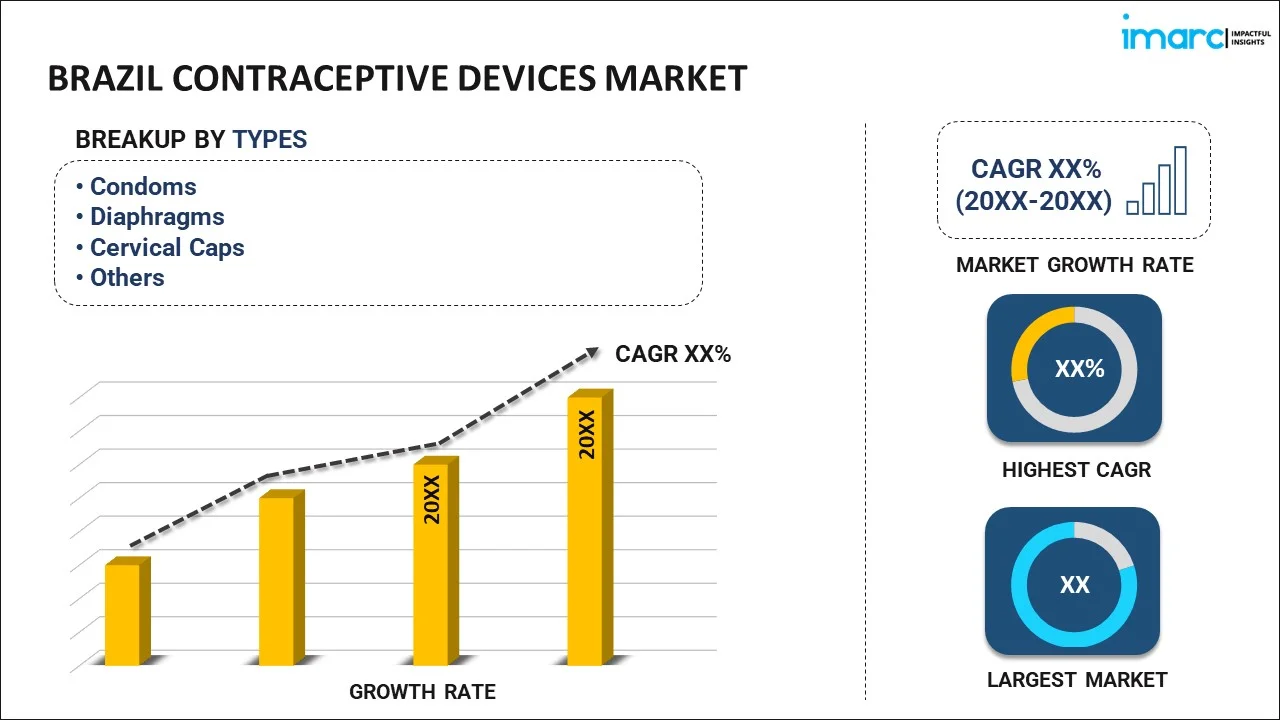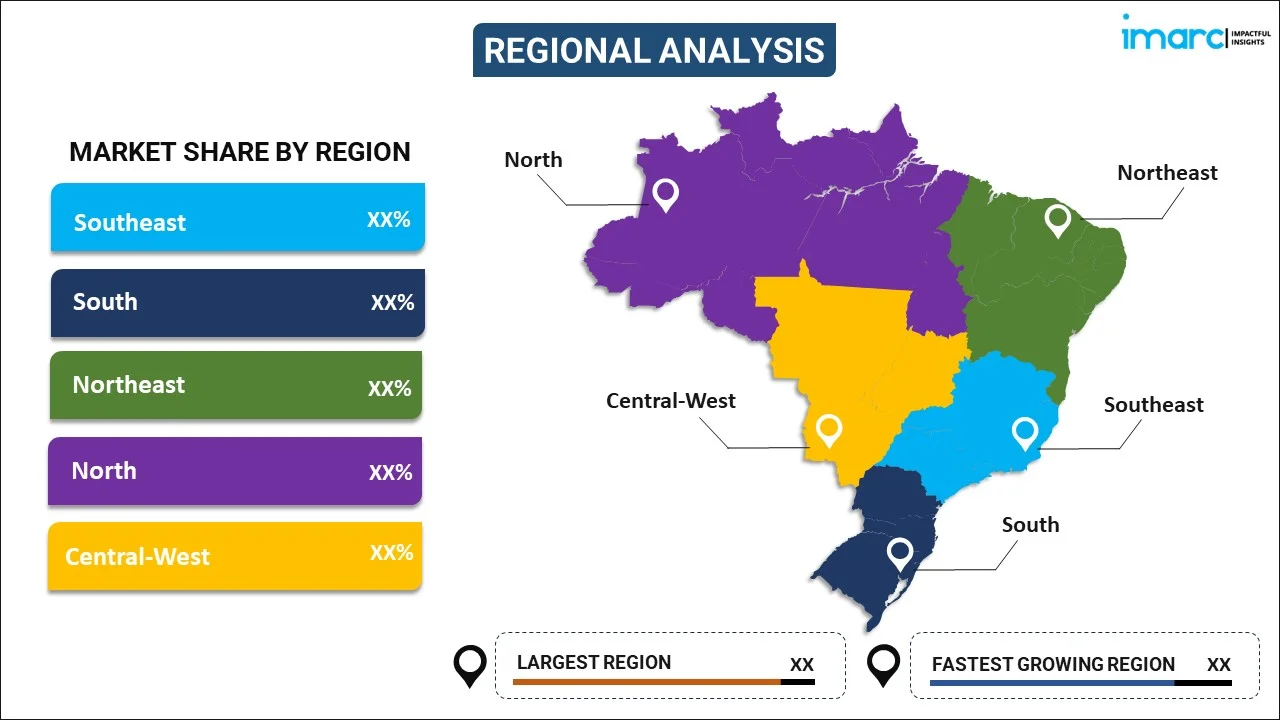
Brazil Contraceptive Devices Market Report by Type (Condoms, Diaphragms, Cervical Caps, Sponges, Vaginal Rings, Intra Uterine Device (IUD), and Others), Gender (Male, Female), and Region 2025-2033
Market Overview:
Brazil contraceptive devices market size reached USD 323.3 Million in 2024. Looking forward, IMARC Group expects the market to reach USD 716.5 Million by 2033, exhibiting a growth rate (CAGR) of 9.14% during 2025-2033. The increased awareness about family planning and sexual health, implementation of educational campaigns, healthcare initiatives, and community-based programs, rising working women population and advancements in contraceptive technology represent some of the key factors driving the market.
|
Report Attribute
|
Key Statistics
|
|---|---|
|
Base Year
|
2024 |
|
Forecast Years
|
2019-2024 |
|
Historical Years
|
2025-2033
|
| Market Size in 2024 | USD 323.3 Million |
| Market Forecast in 2033 | USD 716.5 Million |
| Market Growth Rate (2025-2033) | 9.14% |
Contraceptive devices, often referred to as birth control methods or contraceptives, are tools, devices, or methods designed to prevent pregnancy by either inhibiting the fertilization of an egg by sperm or by preventing a fertilized egg from implanting in the uterus. These devices are an essential part of family planning and reproductive health, providing individuals and couples with the means to control when and if they have children. Contraceptive devices come in various forms to suit different preferences and needs. For instance, oral contraceptives, commonly known as birth control pills, are hormonal contraceptive devices taken daily by women. They contain synthetic hormones (estrogen and/or progestin) that prevent ovulation, thicken cervical mucus, and alter the uterine lining to inhibit fertilization. Moreover, IUDs are small, T-shaped devices that are inserted into the uterus by a healthcare provider. They can be hormonal (releasing progestin) or non-hormonal (copper). IUDs prevent pregnancy by altering the uterine environment, making it less favorable for sperm survival and inhibiting fertilization. Different methods suit different individuals, and are chosen in consultation with a healthcare provider to ensure safety and effectiveness.
Brazil Contraceptive Devices Market Trends:
The Brazil contraceptive devices market is influenced by several key drivers that shape its growth and dynamics. Increased awareness about family planning and sexual health has been a crucial driver in the Brazilian contraceptive devices market. Educational campaigns, healthcare initiatives, and community-based programs have contributed to higher awareness levels among both men and women, encouraging the use of contraceptive devices. Besides, the Brazilian government has played a pivotal role in promoting family planning through various initiatives. Public health programs offer free or subsidized contraceptives, including condoms and birth control pills, to the population. These programs aim to reduce unwanted pregnancies and improve maternal and child health. Moreover, Brazil has experienced significant demographic shifts, including urbanization and changing family structures. As urbanization continues, more women are entering the workforce and delaying childbirth, leading to a greater demand for effective contraception. Furthermore, economic stability and growth contribute to the affordability of contraceptive devices. As individuals and families experience improved economic conditions, they are more likely to invest in healthcare, including contraceptives, as part of their family planning strategy. Additionally, advancements in contraceptive technologyadvancements in contraceptive technology, such as long-acting reversible contraceptives (LARCs) like intrauterine devices (IUDs) and implants, have gained popularity. These methods offer convenience, effectiveness, and a longer duration of protection, reducing the need for frequent interventions, thus propelling the market.
Brazil Contraceptive Devices Market Segmentation:
IMARC Group provides an analysis of the key trends in each segment of the market, along with forecasts at the country level for 2025-2033. Our report has categorized the market based on type and gender.
Type Insights:

- Condoms
- Diaphragms
- Cervical Caps
- Sponges
- Vaginal Rings
- Intra Uterine Device (IUD)
- Others
The report has provided a detailed breakup and analysis of the market based on the type. This includes condoms, diaphragms, cervical caps, sponges, vaginal rings, intra uterine device (IUD), and others.
Gender Insights:
- Male
- Female
A detailed breakup and analysis of the market based on the gender have also been provided in the report. This includes male and female.
Regional Insights:

- Southeast
- South
- Northeast
- North
- Central-West
The report has also provided a comprehensive analysis of all the major regional markets, which include Southeast, South, Northeast, North, and Central-West.
Competitive Landscape:
The market research report has also provided a comprehensive analysis of the competitive landscape in the market. Competitive analysis such as market structure, key player positioning, top winning strategies, competitive dashboard, and company evaluation quadrant has been covered in the report. Also, detailed profiles of all major companies have been provided.
Brazil Contraceptive Devices Market Report Coverage:
| Report Features | Details |
|---|---|
| Base Year of the Analysis | 2024 |
| Historical Period | 2019-2024 |
| Forecast Period | 2025-2033 |
| Units | Million USD |
| Scope of the Report | Exploration of Historical Trends and Market Outlook, Industry Catalysts and Challenges, Segment-Wise Historical and Future Market Assessment:
|
| Types Covered | Condoms, Diaphragms, Cervical Caps, Sponges, Vaginal Rings, Intra Uterine Device (IUD), Others |
| Genders Covered | Male, Female |
| Regions Covered | Southeast, South, Northeast, North, Central-West |
| Customization Scope | 10% Free Customization |
| Post-Sale Analyst Support | 10-12 Weeks |
| Delivery Format | PDF and Excel through Email (We can also provide the editable version of the report in PPT/Word format on special request) |
Key Questions Answered in This Report:
- How has the Brazil contraceptive devices market performed so far and how will it perform in the coming years?
- What has been the impact of COVID-19 on the Brazil contraceptive devices market?
- What is the breakup of the Brazil contraceptive devices market on the basis of type?
- What is the breakup of the Brazil contraceptive devices market on the basis of gender?
- What are the various stages in the value chain of the Brazil contraceptive devices market?
- What are the key driving factors and challenges in the Brazil contraceptive devices?
- What is the structure of the Brazil contraceptive devices market and who are the key players?
- What is the degree of competition in the Brazil contraceptive devices market?
Key Benefits for Stakeholders:
- IMARC’s industry report offers a comprehensive quantitative analysis of various market segments, historical and current market trends, market forecasts, and dynamics of the Brazil contraceptive devices market from 2019-2033.
- The research report provides the latest information on the market drivers, challenges, and opportunities in the Brazil contraceptive devices market.
- Porter's five forces analysis assist stakeholders in assessing the impact of new entrants, competitive rivalry, supplier power, buyer power, and the threat of substitution. It helps stakeholders to analyze the level of competition within the Brazil contraceptive devices industry and its attractiveness.
- Competitive landscape allows stakeholders to understand their competitive environment and provides an insight into the current positions of key players in the market.
Need more help?
- Speak to our experienced analysts for insights on the current market scenarios.
- Include additional segments and countries to customize the report as per your requirement.
- Gain an unparalleled competitive advantage in your domain by understanding how to utilize the report and positively impacting your operations and revenue.
- For further assistance, please connect with our analysts.
 Inquire Before Buying
Inquire Before Buying
 Speak to an Analyst
Speak to an Analyst
 Request Brochure
Request Brochure
 Request Customization
Request Customization




.webp)




.webp)












